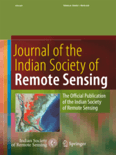
Journal of the Indian Society of Remote Sensing
Scope & Guideline
Connecting Scholars to the Frontiers of Remote Sensing
Introduction
Aims and Scopes
- Remote Sensing Applications:
The journal emphasizes the application of remote sensing technologies in various fields, including agriculture, forestry, urban planning, and environmental monitoring. It seeks to disseminate research that demonstrates innovative uses of remote sensing data. - Data Integration and Analysis Techniques:
There is a strong focus on methodologies that integrate remote sensing data with other data sources (e.g., GIS, in-situ measurements) and employ advanced data analysis techniques, including machine learning and statistical modeling. - Environmental Monitoring and Assessment:
Research aimed at monitoring environmental changes, assessing natural resources, and evaluating the impacts of climate change and human activities is a core theme. This includes studies on land use changes, water quality, and disaster risk assessments. - Technological Innovations in Remote Sensing:
The journal encourages papers that present advancements in remote sensing technologies, including the development of new sensors, imaging techniques, and analytical methods that enhance data quality and application. - Interdisciplinary Research:
The journal promotes interdisciplinary studies that combine remote sensing with other scientific disciplines to address complex challenges, fostering collaboration among researchers from various fields.
Trending and Emerging
- Machine Learning and AI in Remote Sensing:
There is a notable increase in research employing machine learning and artificial intelligence techniques for processing and analyzing remote sensing data, indicating a trend towards more sophisticated analytical methods. - Climate Change Impact Assessments:
Research focusing on the impacts of climate change using remote sensing data is on the rise, reflecting the urgent need to understand and mitigate the effects of climate change on various ecosystems and human activities. - Urbanization and Land Use Change Studies:
With rapid urbanization, studies exploring the dynamics of land use change and their environmental impacts are trending, utilizing remote sensing to assess urban growth patterns and their implications. - Disaster Management and Risk Assessment:
The journal is increasingly publishing studies on disaster management, including flood and landslide risk assessments, showcasing the importance of remote sensing in mitigating disaster impacts and improving preparedness. - Integration of Remote Sensing with IoT and Big Data:
Emerging research is focusing on the integration of remote sensing technologies with Internet of Things (IoT) and big data analytics, enhancing real-time monitoring and decision-making capabilities in various applications.
Declining or Waning
- Traditional Remote Sensing Techniques:
There seems to be a decline in publications focusing exclusively on traditional remote sensing techniques without integration of modern computational methods. The shift towards machine learning and AI applications has overshadowed simpler analytical methods. - Basic Remote Sensing Education and Training:
Research dedicated to foundational education and training in remote sensing appears to be less common, as the field increasingly emphasizes advanced applications and technical innovations, which may lead to a gap in basic educational resources. - Single-Sensor Studies:
Research focusing solely on single-sensor data analyses is waning, with a growing preference for studies that employ multi-sensor approaches to enhance accuracy and comprehensiveness in data interpretation. - Local Case Studies Without Broader Implications:
There is a noticeable reduction in case studies that do not extend beyond local or regional implications. The journal is increasingly favoring research that highlights broader applicability and relevance to global challenges. - Descriptive Studies Without Novel Insights:
The journal appears to be moving away from purely descriptive studies that do not provide new insights or methodologies, favoring innovative research that offers significant contributions to the field.
Similar Journals

CANADIAN JOURNAL OF REMOTE SENSING
Navigating the Dynamic Landscape of Earth SciencesCanadian Journal of Remote Sensing is a prestigious, peer-reviewed journal published by Taylor & Francis Inc., based in the United Kingdom. With an impressive impact factor and a Scopus ranking placing it in the 76th percentile among general Earth and Planetary Sciences, this journal is integral for researchers and professionals exploring the dynamic field of remote sensing. Since its inception in 1975 and now continuing through to 2024, it has been a platform for disseminating cutting-edge research and advancements in both methodologies and applications across diverse environments. As of 2023, it has transitioned to Open Access, ensuring wider access to its scholarly articles, which cover a broad spectrum of topics including satellite imagery, data interpretation, and environmental monitoring. This journal is not only crucial for fostering innovation and collaboration within Earth sciences but also serves as a critical resource for students and academics alike, eager to stay abreast of the latest developments in remote sensing technology and methodology.

Earth Science Informatics
Connecting Researchers to Propel Earth Science Innovations.Earth Science Informatics, published by SPRINGER HEIDELBERG, serves as a premier platform for disseminating innovative research in the realm of Earth and Planetary Sciences. With an ISSN of 1865-0473 and an E-ISSN of 1865-0481, this journal offers insightful contributions that leverage informatics and data-driven approaches to address complex geoscientific challenges. As a testament to its impact in the field, it ranks in the Q2 quartile and holds an impressive 73rd percentile rank among 195 journals in the broader **Earth and Planetary Sciences** category, as per Scopus rankings. This journal invites researchers, professionals, and students to explore and contribute to the growing body of knowledge that bridges the gap between informatics and Earth science, fostering advancements in both theoretical frameworks and practical applications. Situated in Germany, at TIERGARTENSTRASSE 17, D-69121 HEIDELBERG, it aims to enhance interdisciplinary collaboration and propel scientific discovery from 2009 to 2024 and beyond, reinforcing its vital role in the academic community.

Geographia Technica
Advancing Knowledge in Earth Sciences and PlanningGeographia Technica is an esteemed academic journal published by GEOGRAPHIA TECHNICA ASSOCIATION - GT Assoc in Romania, serving as a vital platform for the dissemination of cutting-edge research in the interdisciplinary fields of geography, planning, and earth sciences. Since its inception in 2009 and continuing through to 2024, the journal has established itself as a respected source of knowledge, reflected in its classification within the Q3 category across significant fields such as Computers in Earth Sciences, Earth-Surface Processes, and Geography, Planning and Development. With the ambition to enhance the understanding of socio-environmental interactions and technological applications in these areas, Geographia Technica invites scholars and practitioners to contribute original research that pushes the boundaries of current knowledge. Although currently not listed as open access, the journal's engaging content ensures it remains a valuable resource for researchers, professionals, and students keen on advancing their expertise in these dynamic disciplines.
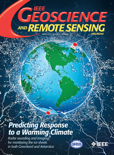
IEEE Geoscience and Remote Sensing Magazine
Advancing Knowledge Through Innovative ResearchIEEE Geoscience and Remote Sensing Magazine, published by the esteemed IEEE-Institute of Electrical and Electronics Engineers Inc, serves as a pivotal platform for cutting-edge research in the realms of geoscience, remote sensing, and related disciplines. With an ISSN of 2473-2397 and E-ISSN of 2168-6831, this prestigious magazine has established itself as a leading resource in its field, achieving a Q1 ranking across multiple categories including Computer Science, Earth and Planetary Sciences, and Electrical and Electronic Engineering. Researchers will appreciate its high impact, recognized by impressive Scopus rankings—2nd in Physics and Astronomy, 3rd in Earth Sciences, and 7th in General Computer Science, placing it firmly in the top percentiles globally. Published bimonthly and compatible with various access options, the magazine aims to disseminate innovative solutions and technological advancements, fostering collaboration and knowledge-sharing among professionals, students, and industry stakeholders. As it converges its contributions from 2013 to 2024, IEEE Geoscience and Remote Sensing Magazine continues to significantly influence the scientific community's understanding of the planet and its systems.
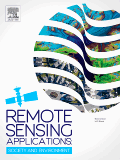
Remote Sensing Applications-Society and Environment
Bridging technology and ecology for a sustainable future.Remote Sensing Applications-Society and Environment, published by Elsevier, stands at the forefront of interdisciplinary research, bridging the fields of remote sensing and environmental science. With an impressive impact factor and recognition within the Q1 quartile in both Computers in Earth Sciences and Geography, Planning and Development, the journal is a vital resource for researchers, professionals, and students committed to advancing our understanding of environmental dynamics through innovative remote sensing technologies. Since its inception in 2015, this journal has cultivated a rich repository of knowledge, addressing pertinent societal and environmental issues, making it a leading source for transformative applications in the field. Accessible and relevant, articles published here not only explore theoretical advancements but also practical implications, ensuring research findings are effectively disseminated to stimulate further inquiries and applications in sustainability and ecological stewardship. The journal's strong Scopus rankings, particularly within its categories, solidify its role as an essential platform for scholarly exchange.
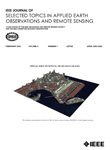
IEEE Journal of Selected Topics in Applied Earth Observations and Remote Sensing
Empowering Scholars with Cutting-edge Earth Observation Research.IEEE Journal of Selected Topics in Applied Earth Observations and Remote Sensing is a premier peer-reviewed journal published by the IEEE-INST ELECTRICAL ELECTRONICS ENGINEERS INC, focused on advancing the field of Earth observation and remote sensing technologies. With an impressive impact factor, this journal ranks in the top quartile (Q1) for both Atmospheric Science and Computers in Earth Sciences, underscoring its significance and influence in the academic community. Open access since 2020, it facilitates broader dissemination of research findings to enhance global visibility and accessibility for researchers, professionals, and students alike. Spanning the years from 2008 to 2024, the journal covers a myriad of topics that highlight innovative applications of remote sensing data and technologies in addressing environmental challenges. With a Scopus ranking placing it in the 91st and 89th percentiles, respectively, in its categories, the journal serves as a vital resource for advancing scholarly discourse and collaboration in Earth sciences.
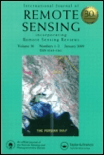
INTERNATIONAL JOURNAL OF REMOTE SENSING
Advancing Knowledge in Remote Sensing for Global ImpactInternational Journal of Remote Sensing, published by Taylor & Francis Ltd, stands at the forefront of Earth and Planetary Sciences, providing a critical platform for disseminating pioneering research since its inception in 1980. With an impressive ranking of #25 out of 195 in general Earth and Planetary Sciences and a notable 87th percentile on Scopus, this journal is recognized for its high-quality contributions that span diverse topics including satellite imagery analysis, geospatial technologies, and environmental monitoring. As a Q1 journal in its field for 2023, it offers invaluable insights and methodologies that are essential for researchers, professionals, and students alike. Although not Open Access, the journal facilitates a comprehensive understanding of remote sensing sciences, ensuring that the scholarly community remains updated with the latest advancements, trends, and applications that impact global challenges.

International Journal of Applied Earth Observation and Geoinformation
Bridging Science and Technology for Global Change.International Journal of Applied Earth Observation and Geoinformation is a premier peer-reviewed journal published by Elsevier, focusing on the integration and application of earth observation and geoinformation technologies across diverse fields. With an open access model established in 2020, this journal enhances accessibility and dissemination of research crucial for addressing global challenges related to climate change, resource management, and sustainable development. The journal occupies a notable position within the academic community, featuring a Q1 ranking in multiple categories including Computers in Earth Sciences, Earth-Surface Processes, and Global and Planetary Change, reflecting its significant impact and relevance in these disciplines. It is recognized for its high-quality articles that explore innovative methodologies and applications, making it an essential resource for researchers, practitioners, and students alike who seek to advance their understanding of earth dynamics and geospatial technology. The journal is indexed in Scopus with impressive rankings that underscore its high citation impact and scholarly influence, with an emphasis on providing a platform for the latest findings in management, monitoring, and policy in environmental science.

ISPRS International Journal of Geo-Information
Empowering knowledge through open access geospatial research.ISPRS International Journal of Geo-Information, published by MDPI, stands at the forefront of the field of geospatial sciences, contributing valuable knowledge and research insights since its inception in 2012. This open access journal, which boasts an impressive collection of articles that emphasize the integration of geographic information systems (GIS) in Earth and planetary sciences, currently achieves a remarkable standing, with a 2023 impact factor ranking in the Q1 category for both Earth and Planetary Sciences and Geography, Planning and Development. Researchers and professionals engaged in the study of spatial data, remote sensing, and innovative geoinformation technologies will find the journal an essential resource, offering diverse perspectives and methodologies. With its open access model, the journal aims to promote the dissemination of knowledge globally, fostering collaboration among scholars while pushing the boundaries of research in geoinformation disciplines. The journal is based in Switzerland and is well-positioned to contribute significantly to the understanding and application of geospatial data for societal advancements.
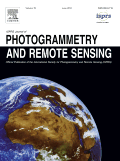
ISPRS JOURNAL OF PHOTOGRAMMETRY AND REMOTE SENSING
Empowering Researchers with Cutting-Edge InsightsISPRS Journal of Photogrammetry and Remote Sensing is a prestigious publication at the forefront of the fields of photogrammetry and remote sensing. Established in 1989 and published by Elsevier, this journal has consistently maintained a strong academic standing, currently holding a top-tier Q1 ranking across multiple categories, including Atomic and Molecular Physics, Computer Science Applications, and Engineering. This reflects its vital contribution to advancing knowledge and technology in these dynamic fields. The journal is not only a vital resource for researchers and professionals but also serves as an essential academic platform for students keen on delving into the latest developments in geospatial sciences. The journal operates under a non-open access model, ensuring that submitted research adheres to the highest standards of scholarly communication and integrity. With an impactful focus, it brings innovative research, comprehensive reviews, and significant case studies to a global audience. The ISPRS Journal is crucial for those aiming to enhance their understanding and application of remote sensing techniques within various scientific disciplines.